|
 |
|
 |
|
 |
|
 |
 |
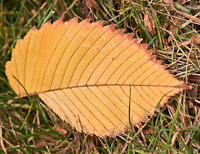 Dutch elm disease, (DED) was introduced into the
Eastern United States
from Europe in about 1920. Since 1950, the disease, transmitted by
bark
beetles, has spread rapidly throughout the Midwest. Today, it is found
throughout the
United States
and in
Eastern Canada as far north as the natural range
of the elm. Dutch elm disease, (DED) was introduced into the
Eastern United States
from Europe in about 1920. Since 1950, the disease, transmitted by
bark
beetles, has spread rapidly throughout the Midwest. Today, it is found
throughout the
United States
and in
Eastern Canada as far north as the natural range
of the elm.
Elms are mostly those that were
planted as street and shade trees in urban areas. They are scattered trees
that escaped the disease, or the 50-70% of the original elm population
in those areas that maintained control programs.
Although only a fraction of the original elm population remains, DED
is still a major concern among many urban residents and those involved
with the care and maintenance of city trees. This bulletin presents guidelines
for extending the life of the remaining elms. It should be noted that DED
losses are now occurring and will continue to occur. Thus, when we speak
of DED control, we are referring to the reduction of the rate of loss,
not to a complete elimination of the disease.
Cause and Transmission of DED
Dutch elm disease is caused by the fungus,
Ceratocystis ulmi.
The tiny spores ("seeds") of this fungus germinate in the water-conducting
tissues of the living elm tree. As the fungus grows, it causes the tree
to form gums that plug the water-conducting tissues. This condition causes
the tree to wilt and die. Many trees die in the same season that infection
occurs-some die within a few weeks. Only a few live longer than the second
or third season and even fewer recover completely.
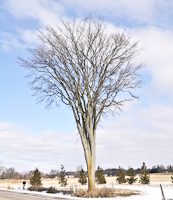 All elms are susceptible to DED, with the American elm being the
most susceptible. Chinese and
Siberian elms are highly resistant to the
disease, although individual trees have died from the disease.
Several hybrid elms, produced both in this country and in Europe, have
been advertised as immune or resistant to Dutch elm disease. None of these
hybrids are actually immune, but some of them do show resistance approaching
immunity. The Asiatic species and many of the hybrids grow faster than
our native elms. Some selections, however, are not winter-hardy or are very susceptible to diseases other than Dutch elm disease. All elms are susceptible to DED, with the American elm being the
most susceptible. Chinese and
Siberian elms are highly resistant to the
disease, although individual trees have died from the disease.
Several hybrid elms, produced both in this country and in Europe, have
been advertised as immune or resistant to Dutch elm disease. None of these
hybrids are actually immune, but some of them do show resistance approaching
immunity. The Asiatic species and many of the hybrids grow faster than
our native elms. Some selections, however, are not winter-hardy or are very susceptible to diseases other than Dutch elm disease.
When adult bark beetles leave diseased elm trees, fungus spores
enter healthy trees through the feeding wounds made by the adult bark beetles.
Wounds are usually made in the crotches of 1- and 2-year-old twigs of healthy
elm trees.
Many communities have continued to lose elms even though
they have carefully followed the conventional control measures of sanitation
and spraying. Most of this loss can be attributed to the fungus passing
through natural root grafts between diseased and nearby healthy trees.
The extent of this type of transmission varies with the spacing distance
between trees. Elms over 40 feet apart are seldom united by a root grafts,
while trees less than 20 feet apart are frequently connected.
|
 |
|
 |
 |
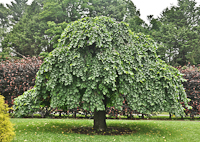 The most noticeable symptom of Dutch elm disease is the wilting
of one or more branches of the infected trees. The wilting leaves become
yellow and, later, turn brown when dead. Branches with dead, brown leaves
may hang among the green foliage of healthy branches, a further sign that
the tree may have the disease. The most noticeable symptom of Dutch elm disease is the wilting
of one or more branches of the infected trees. The wilting leaves become
yellow and, later, turn brown when dead. Branches with dead, brown leaves
may hang among the green foliage of healthy branches, a further sign that
the tree may have the disease.
There is only one way you can be sure that a tree has Dutch elm
disease. Diseased twigs and branches must be examined for the fungus by
a plant pathologist using laboratory methods.
Here's what you do:
1. Cut six twigs about 7 inches long and 1/2 to 1 inch in diameter
from the diseased branches of each tree.
2. Mark the twigs from each tree.
3. Wrap and bind securely in a suitable cardboard box for mailing. Do
not send material that has been dead for some time or which does not show
the discolored ring under the bark.
4. Send all samples for Dutch elm disease testing to the Dutch
Elm Disease Identification Laboratory.
If you have further questions about sending in samples for identification,
check with your county
Extension
Service agent.
Note: It is very important that you mail the samples immediately
after collecting. Delay in getting the twigs to the laboratory only makes
the problem of identification harder.
|
Beetles
that Transmit the Disease
In the U.S., the fungus which causes DED is transmitted largely by two
species of elm bark beetles: the smaller European bark beetle, Scolytus
multistriatus (Marsham); and the native elm bark beetle, Hylurgopinus rufipes (Eichhoff).
The smaller European bark beetle is the most common
vector and usually displaces the native species where
they initially occur together. This beetle was first
introduced to the
United States
from Europe in 1909 and has now
been found in every state except Florida, Hawaii, and
Alaska.
Beetle Description
Although similar in size, 1/8" long (2-3.5 mm.), both the European and
native elm bark beetle are easily distinguished.
The European species has a shiny two-toned appearance: the wing
covers are dark, reddish-brown while the head and thorax region (prothorax)
is black. In contrast, the native elm bark beetle is uniformly gray-to-brown
in color, with coarsely punctured depressions on the hind wing covers.
Silhouettes of the adult beetles are also unique. The European beetles
have a concave posterior while the native species has a more rounded or
dome-like outline.
Life History
The smaller European elm bark beetle over winters as a larva beneath
the bark of dead or weakened elms (brood wood). Adult beetles emerge through
small holes in the bark beginning in late May and early June. They immediately
fly to living elm where they feed in the crotches of 2- to 4- year-old
twigs. The beetles may be covered both externally and internally with as
many as one million spores of the sticky DED fungus.
Although healthy elms are preferred for feeding, beetles usually
breed in dead or dying elm wood with intact bark. The adults of the smaller
European elm bark beetle bore through the bark and construct grooves for
their eggs, parallel to the grain of the wood. Upon hatching, the legless,
white grub-like larvae feed in the inner bark (phloem) and wood surface.
Their feeding creates mines that radiate somewhat perpendicularly from
the egg gallery leaving an elliptical pattern.
Complete development from egg to adult takes about 6 weeks. A
second generation of adult beetles begins to emerge in mid-July and continues
through September. However, disease transmission by these late season beetles
is insignificant compared to infections caused by the spring generation
of beetles.
The native elm bark beetle has a similar life history but with
several important exceptions. Like the European species, it may over-winter
as larvae in brood wood and emerge in June and July. However, some adults
may emerge in April and May, about 2 weeks before the smaller European
elm bark beetle adults appear, and feed through the bark (not in the crotches)
of healthy branches 2 to 4 inches (5 to 10 cm) in diameter. Adults then
fly to dying elm wood to breed. In contrast to the European species, native
females form egg galleries that run perpendicular to the grain and larvae
tunnel along the grain creating a butterfly-shaped pattern.
There are also significant differences in the breeding habitat
preferences of these beetles. The European bark beetle occurs more frequently
in elms along city streets yards, and parks, while the native species prefers
shaded habitats, especially woodlot and forested areas. When both occur
on the same tree, the sunny portions of the tree are colonized by the European
beetle and the shaded limbs and lower tree bole by the native beetle. Usually,
the native species is displaced by the more aggressive European species.
|
 |
 |
 |
There is no one single control program that is correct for all elms.
There are, as we will see, different degrees or levels of control. But
the initial question which must be answered is, "How valuable is that elm
tree to the owner and what is the owner willing to spend on control?" The
important point is to match the level of control to the value of the trees
and your financial resources. What is right for one city is not necessarily
right for another.
The control of DED can be achieved through: a community program
and a program for the individual homeowner. We will list various management
techniques and show how to combine these methods to meet the needs of different
types of owners.
For control, it is important to understand the life cycles of
the fungus, its transmittal, and the growth habits of elm. As mentioned
earlier, the fungus survives and proliferates in diseased, dying and recently
killed elm trees. The two elm bark beetles which transmit DED prefer these
trees as sites for over-wintering and brood production. When adult beetles
emerge in the spring, they fly to healthy elm trees to breed. Finally,
elm trees planted in close proximity often form root grafts that may connect
several trees underground.
|
|
Control Alternatives:
Sanitation - Root Grafts -
Maintenance -
Insecticides - Fungicides |
1. Sanitation
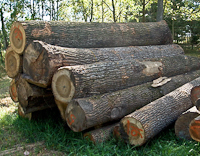 Sanitation is the most important and effective step in preventing
the buildup of elm bark beetle populations. Any elm wood with intact bark,
e.g. firewood, tree stumps, broken or dead limbs, and trees killed by disease,
drought, or storms are ideal breeding habitats for bark beetles. Consequently,
all recently dead or dying elm wood must be destroyed to reduce beetle
populations and the probability of disease transmission. Proper disposal
consists of removing all bark and burning, chipping or burying wood more
than 4 inches in diameter. Major sanitation efforts should be directed
at larger wood. Sanitation is the most important and effective step in preventing
the buildup of elm bark beetle populations. Any elm wood with intact bark,
e.g. firewood, tree stumps, broken or dead limbs, and trees killed by disease,
drought, or storms are ideal breeding habitats for bark beetles. Consequently,
all recently dead or dying elm wood must be destroyed to reduce beetle
populations and the probability of disease transmission. Proper disposal
consists of removing all bark and burning, chipping or burying wood more
than 4 inches in diameter. Major sanitation efforts should be directed
at larger wood.
Since beetles are capable of flying several miles, sanitation
must be practiced on an area-wide basis, i.e., entire municipalities, to
be effective. Sanitation alone will not prevent the disease from spreading
but it will reduce the infection rate and provide time for tree replacement.
Several communities with good sanitation programs are holding
their annual losses to 1-3%. As the wild elms around these communities
are eliminated, the degree of control achieved by sanitation alone is increasing.
Certainly, the greatest return per dollar comes from those spent on sanitation.
Limbs and trees killed by the disease (or any other cause) in urban or
suburban areas must by removed sooner or later because of their liability
to property and people. Prompt removal not only solves this problem, but
is also the most important step a community can take in reducing DED.
To achieve a high degree of control through sanitation, all trees
must be checked for DED and the presence of elm bark beetles at least twice
a year-late June and again in late July or early August. Three surveys
are much better. Destroy all diseased, dead or beetle infested wood located
in the first or second survey within 14 days. Destroy similar material
found later in the summer before May 1 of the following year. If elm wood
is saved for firewood, remove the bark to prevent the bark beetles from
over-wintering in it.
2.
Destruction of Root Grafts
Studies have shown that over 50% of the trees lost, particularly in
communities with good sanitation and bark beetle control, become diseased
via root grafts. Any community seriously interested in controlling the
disease should destroy any potential root grafts between diseased and healthy
trees by mechanical or chemical means.
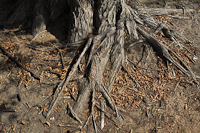 Where elms are planted close (within 40 feet or less of each other)
consider thinning the stand during normal tree maintenance operations.
Remove trees that have poor vigor. This action will have several benefits:
1) lower vigor trees are more attractive to beetles, thus more prone to
attack by DED, 2) the remaining trees will benefit by the reduced competition
for light, nutrients and water, and 3) many root grafts will be destroyed,
which may help slow the spread of DED through the remaining stand. Where elms are planted close (within 40 feet or less of each other)
consider thinning the stand during normal tree maintenance operations.
Remove trees that have poor vigor. This action will have several benefits:
1) lower vigor trees are more attractive to beetles, thus more prone to
attack by DED, 2) the remaining trees will benefit by the reduced competition
for light, nutrients and water, and 3) many root grafts will be destroyed,
which may help slow the spread of DED through the remaining stand.
Destruction of root grafts can be best accomplished with the soil
sterilant Vapam. This fumigant is also known as VPM, SMDC, and sodium N-methyl-dithiocarbonate.
This chemical has been found to kill elm roots in a limited zone thus providing
a method for chemical root pruning. Apply Vapam immediately after a tree
is diagnosed as having Dutch elm disease if it is within 50 feet of a healthy
elm. If trees are less than 20 feet apart or if a diseased tree has advanced
wilt symptoms, it is necessary to treat at two sites: between the diseased
and the first healthy-appearing tree, and between the first and the second
healthy- appearing tree. This is advisable because the fungus may have
already passed from the diseased to the first healthy-appearing elm before
Vapam was applied.
Place the line of treatment so as to kill the roots of the two
adjacent trees that are likely to be
grafted. This can best be accomplished
by applying the chemical in an unbroken, straight line equidistant between
the diseased and adjacent healthy elm. However, the line of holes should
be at least 10 feet from the trunk of the healthy tree. If sidewalks, hedges,
or other plant material prevent application is a straight line, then apply
the chemical in a T-shaped or L-shaped pattern.
Drill holes approximately 3/4 inch in diameter, 15 to 20 inches
deep, and 6 inches apart. Fill holes with Vapam, diluted one part Vapam
to three parts water. Seal each hole carefully by tamping to prevent gas
dissipation. A circle of grass 3 to 6 inches in diameter is usually killed
around the point of infection. After 4 to 6 weeks the dead spots can either
be resodded or reseeded. Allow two weeks after treatment before removing
the diseased tree.
3.
Tree Maintenance
Two recent studies on pruning diseased wood have shown that 30
to 60% of the diseased trees can be saved, at least temporarily. Pruning
must be done promptly (within 1 to 3 days of first symptoms). The greater
the development of the disease within the tree, the less chance of success.
Any trees with multiple infections or with more than 10% of the foliage
showing symptoms are poor
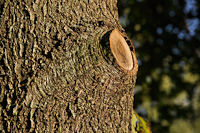 candidates for sanitary pruning. If the pruning
cut is made at least 6 feet below the last visible discoloration in the
wood, the chances of successfully eliminating the disease are doubled.
Sanitation pruning is probably only justified where the disease is restricted
to a small portion of a specimen tree with high value. Communities with
a good integrated control program should not allow pruning to weaken their
sanitation program. candidates for sanitary pruning. If the pruning
cut is made at least 6 feet below the last visible discoloration in the
wood, the chances of successfully eliminating the disease are doubled.
Sanitation pruning is probably only justified where the disease is restricted
to a small portion of a specimen tree with high value. Communities with
a good integrated control program should not allow pruning to weaken their
sanitation program.
All shade trees should be on a regular maintenance program which includes
fertilization, watering during droughts and removal of dead or dying branches.
Note, however, that removal of healthy branches during the summer may increase
the incidence of Dutch elm disease. This type of trimming is employed by
certain communities once every 5 to 10 years, to shape trees and remove
branch obstructions above streets, houses, wires, etc. As a result, trimmed
trees are attractive to the small European elm bark beetle which invades
the main trunk to lay eggs. Beetles introduce the fungus and, while the
trees may appear vigorous in the fall, trees wilt and die rapidly the following
spring.
4. Insecticide
Sprays
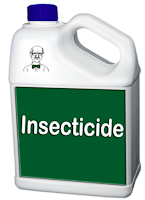 The application of contact
insecticides to control bark beetles
has been one of the main tactics of DED programs for many years. A major
problem is coverage of all bark surfaces, especially twig crotches, with
enough material to kill feeding adults for an extended period of time.
There is current speculation whether adequate insecticide coverage of all
bark surfaces is possible, using conventional application techniques. A
beetle spray program may add little to DED protection compared to what
can be achieved through a good sanitation program. The application of contact
insecticides to control bark beetles
has been one of the main tactics of DED programs for many years. A major
problem is coverage of all bark surfaces, especially twig crotches, with
enough material to kill feeding adults for an extended period of time.
There is current speculation whether adequate insecticide coverage of all
bark surfaces is possible, using conventional application techniques. A
beetle spray program may add little to DED protection compared to what
can be achieved through a good sanitation program.
When both beetle
species are present, thorough coverage of all bark surfaces is necessary.
Where only the smaller European species occurs, coverage of small twigs
(1 to 4-year-old wood) is critical. When the native species is the primary
vector, sprays of an insecticide labeled for this problem applied to the lower trunk (basal
3 to 4 feet) in the fall or spring will control adult beetles.
Several types of application equipment can be used with varying effectiveness
for dormant sprays. Hydraulic sprayers provide good coverage throughout
the crown but require considerable time and labor. Helicopter application
provides good coverage of the upper crown and may be less expensive when
large numbers of trees are involved. Ground-operated mist blower effectiveness
tends to be limited to smaller trees since coverage of the upper crown
is often spotty. In all cases, the addition of a 5 to 10% solution (by
volume) of a horticultural grade oil (80 or 90 sec.) to the spray mixture
will help prevent damage to automobile finishes.
5. Systemic
Fungicides
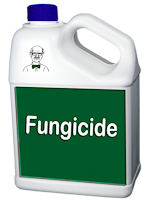 Arbotect 20-S and other closely related materials are currently
registered as an aid in DED control. Only trained, licensed pesticide applicators
are permitted to use these chemicals, and then only as directed. Although
there is still disagreement among researchers concerning the effectiveness
of systemic fungicides, they are clearly the least effective and most expensive
method of DED control. In addition, presently registered methods of injection
can cause severe physical injury to the tree. Systemic fungicides are not
a cure-all and should never be used as a substitute for other control methods. Arbotect 20-S and other closely related materials are currently
registered as an aid in DED control. Only trained, licensed pesticide applicators
are permitted to use these chemicals, and then only as directed. Although
there is still disagreement among researchers concerning the effectiveness
of systemic fungicides, they are clearly the least effective and most expensive
method of DED control. In addition, presently registered methods of injection
can cause severe physical injury to the tree. Systemic fungicides are not
a cure-all and should never be used as a substitute for other control methods.
|
Summary
We have discussed the various methods of DED control. How can these
methods be integrated into a successful DED control program, first for
a community and secondly for an individual elm owner outside a control
area?
DED can be controlled best on a community-wide basis. The necessary
technology has been available for at least 20 years and many municipalities
have controlled the disease using this knowledge. Exactly what can and
should be done depends on the value of the elms and the economic resources
of the owners. The bare minimum that any group or individual should do
is sanitation, for these funds must be spent sooner or later to remove
the dead trees. Frequent and thorough surveys followed by prompt removal
of diseased trees will save money as well as elms.
The second level of control is to add root graft control, methoxychlor
application and good tree care. If properly done, this 4-prong attack should
keep annual losses to less than 2%. The use of all four steps is essential
if DED losses are to be held to a minimum. If a community does not have
the financial resources to apply all controls to all of their remaining
elms, they should evaluate their elms and concentrate a complete control
effort on the most beautiful and desirable trees. All control measures
should be used to save this limited number of trees.
The individual who owns an elm outside of a control area is going
to have an extremely difficult job in preventing DED mainly because no
meaningful sanitation program can be carried out. However, disease control
is possible for the few elms which remain alive after most of the surrounding
elms have died. Nature has already conducted her own sanitation program
so that the number of elm bark beetles and the amount of fungal material
have been greatly reduced compared to the epidemic years. The least expensive
program, and perhaps as effective as any other program under these circumstances,
is to watch the tree very carefully for any symptoms of DED. At the first
signs of wilt, prune the diseased portion. An owner with greater economic
resources and a valuable tree should consider spraying with methoxychlor.
While the degree of control achieved with methoxychlor would not be as
great as when used in a community program, its use would decrease the risk
of DED. If more than one tree is involved and they are less than 30 feet
apart, root graft control will be necessary. This could be done even before
any of the trees become infected to be sure the grafts are non-functional.
While the odds are against an individual saving any particular
elm, those owners who have the resources and inclination can save some
of these elms or at least prolong their life.
Other methods of combating DED have been suggested or are under
investigation. DED resistant elms are a possibility and some selections
have already been released. If a truly disease-resistant tree with desirable
horticultural traits could be developed, this would be the ultimate in
DED control as, once established, no additional expense would be required.
However, no such tree exists and it is doubtful if it will exist in the
near future. Recent research has shown the fungus which causes DED to be
very variable with some strains much more pathogenic than others. The Dutch
who worked to develop resistant trees for 60 years have found that some
of their most promising selections are susceptible to these new strains
of the fungus. There are many other problems involved in the development
of disease resistant trees such as susceptibly to other diseases, especially
phloem necrosis, and winter hardiness.
Occasionally, one reads about other DED cures such as zinc nails,
kerosene, Epsom salts or some other mysterious potion for which the creator
claims great things. Many of these materials have been carefully tested
as control agents in federal or state laboratories. None have significantly
reduced DED.
Hopefully, we have learned a lesson from DED: diversity. Never
again should we allow 50 to 90% of the shade trees in a community to be
of a single species. While man may like to have a whole avenue or subdivision
of one type of tree, this is extremely hazardous because nature can retaliate
dramatically and destructively against uniformity. Many mid-western communities
lost nearly all of their shade trees in a decade or less because nearly
all of their shade trees were elms. Much of nature's strength lies in her
diversity. Rarely does a single factor such as disease wipe out a species
in undisturbed nature. It is only when man enters the picture and unifies
the environment that the stage is set for an epidemic. Most serious plant
diseases are host specific. Therefore, even if a serious pest does attack,
only a small portion of the total need be lost if the original risk was
spread among many species.
|
|
 |
|
Note: We
have provided some general information and
observations on this topic aimed at the home
gardener. Before you take
any serious action in your landscape, check
with your state's land grant university's
Cooperative
Extension
Service for the most current,
appropriate, localized recommendations. |
|
 |
|



